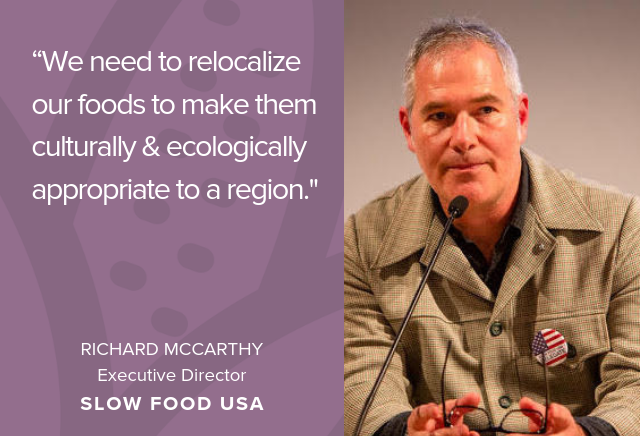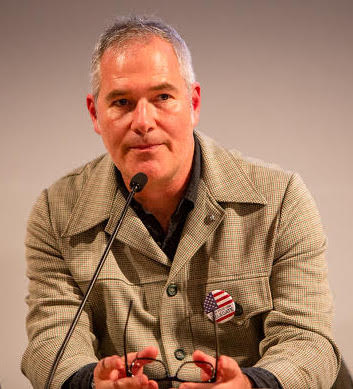
From January 7 – February 8, Food+Tech Connect and The Future Market are hosting Biodiversity: The Intersection of Taste & Sustainability, an editorial series featuring interviews with over 45 leading food industry CEOs, executives, farmers, investors and researchers on the role of biodiversity in the food industry. See the full list of participants and read about why biodiversity in food is important here.
We have been talking about incorporating more biodiverse ingredients into products and our diets over the last month, but where do you find those ingredients? Since 1996, Slow Food has been building the International Ark of Taste, a database of nearly 5,000 endangered foods from over 150 countries. With this database it hopes to catalogue and encourage greater use of foods forgotten by the industrial food industry. It is also launching campaigns to raise awareness of these endangered food. This spring, it is incentivizing 3,000 farmers, school gardens and Slow Food chapters to plant the seeds of endangered crops.
Below, I speak with Slow Food USA Executive Director Richard McCarthy about how the organization is encouraging greater diversity in regional food sheds. He argues for the need to move from mass production and monocropping to reclocalizing our foods to make them culturally and ecologically appropriate.
Danielle Gould: How does your organization define and think about biodiversity?
Richard McCarthy: Slow Food sees biodiversity as natural assets to be preserved and utilized.
DG: What is your organization doing or planning to do to promote biodiversity?
RM: Inspired by the idea that we must “eat it, to save it,” we believe that storing seeds is not enough. It is important to create popular excitement for heritage breeds and seeds. Slow Food’s living catalogue of endangered foods, the Ark of Taste, is our primary tool to identify and recognize foods that the world of industrial food deems archaic, unuseful and destined to be left behind. Of course, we feel differently. These are the foods that provide more options for farmers, gardeners, cooks and chefs to navigate gastronomic decisions in an age of climate change. With Slow Food’s desire to trigger behavior change, we launch campaigns to draw connection between individual choice and systems change. This spring, we will incentivize 3,000 farmers, school gardens and Slow Food chapters to Plant A Seed of Ark of Taste vegetables to popularize forgotten seeds.
DG: What does an ideal biodiverse food system look like? How do you measure biodiversity, and when will we know when we’ve arrived at a “good” level of biodiversity?
RM: An ideal biodiverse food system is one in which every region brands itself as “home of ______.” The tyranny of scale shoves farmers, chefs and flavors down a narrow corridor to plant the same products. This industrial thinking is what has yielded the 90 percent decrease in biodiversity in North America in the last 100 years. Even progress to counter these trends conform to industrial thinking. Consider the trends that convince farmers to “meet demand”: kale, brussels sprouts, arugula. On the one hand, the rise of “specialty crops” like these may be, on first blush, good news. What happens is that trends take off and every farmer follows suit. What if instead, we — producers and consumers — identify iconic products for each food shed; rally around these products; partner with chefs and others to get these products into production, supply and the popular imagination for eaters of all walks of life to cherish that which differentiates where we live from places others’ live.
DG: How would you describe the current state of biodiversity? What are the key forces that are helping or hurting biodiversity today?
RM: It is difficult to be optimistic when the culture of confinement permeates all stages of the food chain: We are losing biodiversity at an alarming rate. The primary culprit is our devotion to cheap meat. It puts undue pressure on animals, ecosystems and economies. We confine animals, money and palates. We demand that we will can have as much meat as we want, when we want and not consider the hidden costs. Worse, we export this model all over the planet. As a result, places like Para in Brazil enables land speculators to introduce monocrop soybean cultivation on land previously inhabited by small farmers whose integrated farms regenerate soil and economies. Instead, soybeans are raised by large farms, sold to Cargill and transported to Europe for feed to produce Chicken McNuggets. This economic model destroys biodiversity. When we as individuals and institutions opt out of the monocrop economy, we support the ecology of local economies: from farmers markets to school systems that purchase local, fresh and sustainable products.
DG: What’s at stake for our society if biodiversity is reduced? Are there examples where a lack of biodiversity has caused problems within an ecosystem or community?
RM: When we reduce biodiversity, we restrict our society’s ability to be agile. Already, our over-dependence upon corn and a few grains to be part of nearly every meal we consume has gutted rural economies of their wealth, flooded waterways with chemicals and offshore fisheries with “deadzones,” and generations with intolerance to food. Perhaps the most vivid and well-documented example of this over-reliance upon a monocrop economy is the 19th century potato famine in Ireland. When colonialism — neo or old-school — results in a majority of a population consuming only one crop, then people and planet suffer.
DG: What is the scientific and/or business case for a biodiverse food system?
RM: The scientific and business case is the same for biodiversity. Don’t put all of your eggs in one basket. Centralization is bad for economic health. If every farm is growing the same crop and selling to the same customer, then short term competitive decisions outweigh long-term ones. Cost-cutting measures undermine future investment in land and people.
DG: What investments need to be made to create a more biodiverse food system?
RM: For one, let’s stoke eater demands for new flavors by reviving old crops and old breeds by leveraging the behavior change institutions that meet the public where and when they shop: Campaigns in farmers markets, with supportive retailers and via imaginative tourism. At the same time, let’s underwrite farmers to experiment with more diverse varieties of seeds and breeds. For fishers, let’s help them disengage from the commodity corridor of shrimp sold at the dock. Instead, make the most of bycatch, reward quality over quantity.
Second, let’s rethink school lunch as an academic subject. Grow the next generation of good eaters who run towards new and interesting foods because they eat it at school and have a contextual relationship with the foods’ history and geography. And, of course, they love how it tastes. Change the culture of the cafeteria, as if we actually care about the children and to enjoy a future free of chronic diseases. This involves: purchasing endangered seeds and breeds directly from local farmers; ripping out all vestiges of the Fordist cafeteria line that treats children as cogs in a wheel and replacing it with civic lessons that teach children to cooperate and eat family style; and utilizing the power of the public purse to help farmers to shift from growing one commodity and to growing for one school. A tall task? What’s the alternative? This could represent a Marshall Plan for rural America and a cornerstone for a future that rewards innovation, biodiversity and the reinvention of tradition in agriculture.
DG: How might we reinvent capital structures or create incentives to increase investment in biodiversity?
RM: Nearly 95 percent of the Farm Bill invests in a monocrop economy. Get big or get out; takes risks and suffer the consequences. What if instead, we grew the 5 percent of the Farm Bill that rewards farmers to be good stewards of the land, urban consumers to forge ties with rural communities and public health policies that recognize the risks involved with changing eating behaviors. If we liberated rural communities from this culture of confinement, then we could invest in a generation of entrepreneurs who want to return to the land to grow food and dignity and wealth. Change is difficult. Good public policy is like good investment models: They mitigate risk. We should incentivize farmers to develop farms that integrate animals, direct marketing, cooperation with neighboring farmers and long-term land management (in order to diversify the ecology of the land and improve the water and air).
DG: What are some of the most important things food manufacturers, chefs, retailers, farmers, and other key parts of the supply chain can do to support biodiversity?
RM: Champion old varieties of fruits and vegetables, old grains and more meals that use no meat, or at least meat as flavor and not focus of every plate. These steps are huge gifts for farmers seeking guidance as to what to grow and for whom. Consumers can change supply when working closely with farmers. High volume customers speak the loudest, however, it is the small consumer who gets the ball rolling.
DG: Where can consumers and food industry professionals go to learn more about biodiversity issues and what they can do to help?
RM: There are many good resources to turn to. For one, the Slow Food Ark of Taste is a great starting point to stoke excitement about the biodiversity we are losing everyday. However, there’s no substitute for picking up a seed catalogue and spending time with farmers to map out the next season of planting. Can’t find a farmer? Visit your nearby farmers market. Every retailer who’s seeking trends, starts there first to get ahead of the wave.
DG: What are some examples of food products that promote biodiversity?
RM: The proliferation of heirloom tomatoes is one great example of how behavior is changing. Farmers are adapting to meet consumers who crave food that tastes of a place and a particular time. Many heirloom tomatoes are difficult to transport, which alone is an indicator of how limitations and scarcity can reward the farmer who undertakes the risk to change.
DG: If we get to a perfectly biodiverse food system, how would that change the typical selection of products we see in a grocery store?
RM: Travel outside of the USA and you see it already. Stores in Japan stock 80 percent of their shelves with fresh, local and seasonal products. This is not perfection, however, Japanese consumers — of all walks of life — value taste. Stores adapt to that impulse. This is something that is happening in the USA but it’s still small, weak. Farmers market shoppers are walking into grocery stores with a different set of assumptions.
DG: What, if any, exciting products, technologies or services are you seeing that support a more biodiverse food system?
RM: The desire for fermented foods, for one, is widening our sense of what tastes good. No one really saw this coming. Where did it begin? On the margins. Young people become fascinated with gut health, old canning techniques, and flavor. Similarly, the raw milk societies that operate on the margins and in the grey zone are changing expectations about public health, the right to choose, and how the industrial food system is designed to squelch choice.
DG: Are there certain products you would like to see more of in the food industry — either in foodservice or CPG — that would help promote a more biodiverse agricultural system?
RM: There are over 300 products in the USA living catalogue of endangered foods, the Ark of Taste. Some of these are working their way onto dinner tables. A few come to mind that are ripe for rediscovery at commercial levels: The Sebastopol Gravenstein apple, Louisiana satsuma, the Ohio Valley Paw-Paw. However, maybe the question is part of the problem. The Ark of Taste captures the most vulnerable and endangered foods. Few are poised for mass production. More importantly, we need to begin to think beyond mass consumption. We need to relocalize our foods to make them culturally and ecologically appropriate to a region. Maybe we should deploy import substitution thinking at the regional level. What products are currently on the menu that could be substituted with others that are produced locally?
DG: What is your vision for what a more biodiverse food system looks like in 10-15 years?
RM: One in which the kids in today’s schools grow up to raise their families on home-cooked meals from fruits and vegetables raised in backyards and community gardens. If this occurs, it’s because we’ve created a culture that demands more from life: Work less, earn more; spend more time with each other around the table. The pressures families feel today are the very same ones that confine farmers to a monocrop economy.
DG: Anything else you want to share?
RM: A love for cooking and eating. Only when we shed the perception that these are elitist notions will we rediscover that our grandparents were hipsters, that immigrants possess traditional knowledge that will rescue biodiversity from the scientists and economists that wish to subject us to fewer choices and less love for people, planet and parsnips.
Read all of the interviews here and learn more about Biodiversity at The Future Market.
_______________________________
 Richard McCarthy, Executive Director of Slow Food USA
Richard McCarthy, Executive Director of Slow Food USA
An early innovator in the late-20th Century farmers market renaissance to reconnect urban consumers to rural producers, he founded Market Umbrella in New Orleans, where its flagship Crescent City Farmers Market launched some of the first health incentive programs. After Hurricane Katrina, the Market served as a fulcrum for social, economic and philanthropic reinvention for the region’s food system. Writer, lecturer, and community development specialist, at Slow Food, Richard launches campaigns, stages global gatherings and forge partnerships with expected and nontraditional partners to change the world through food that is good, clean and fair for all.





